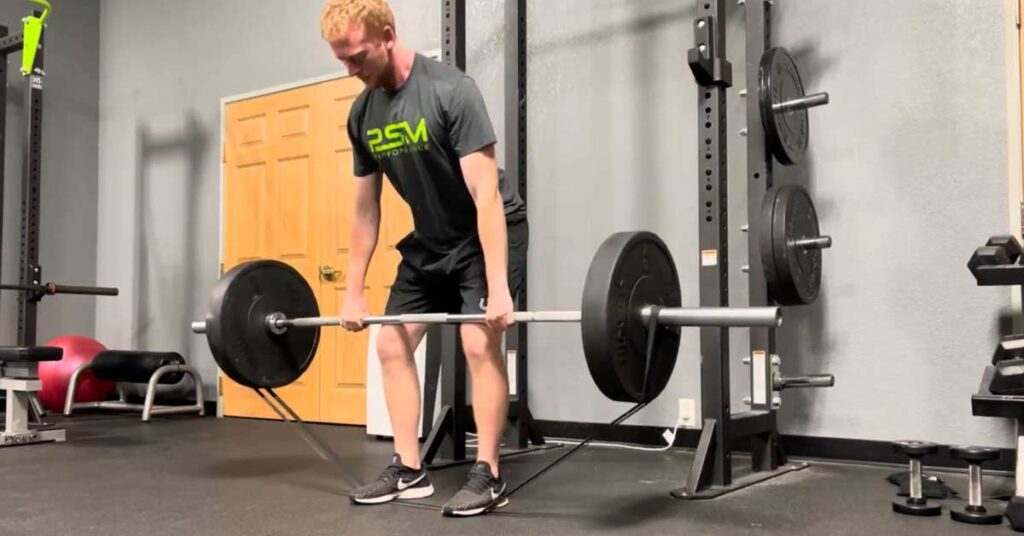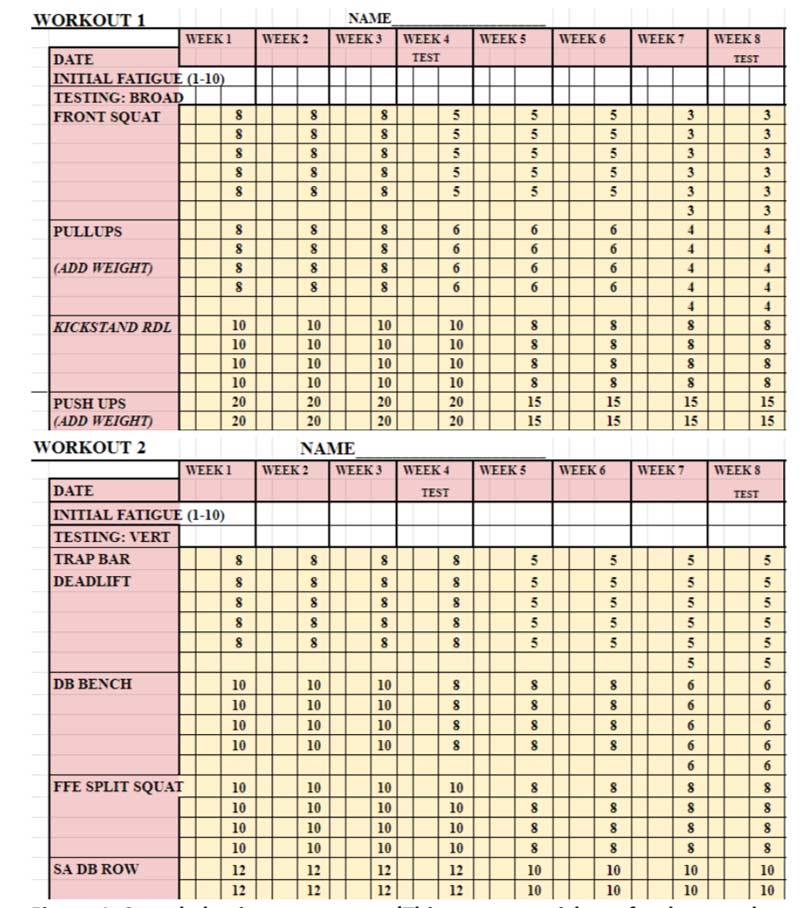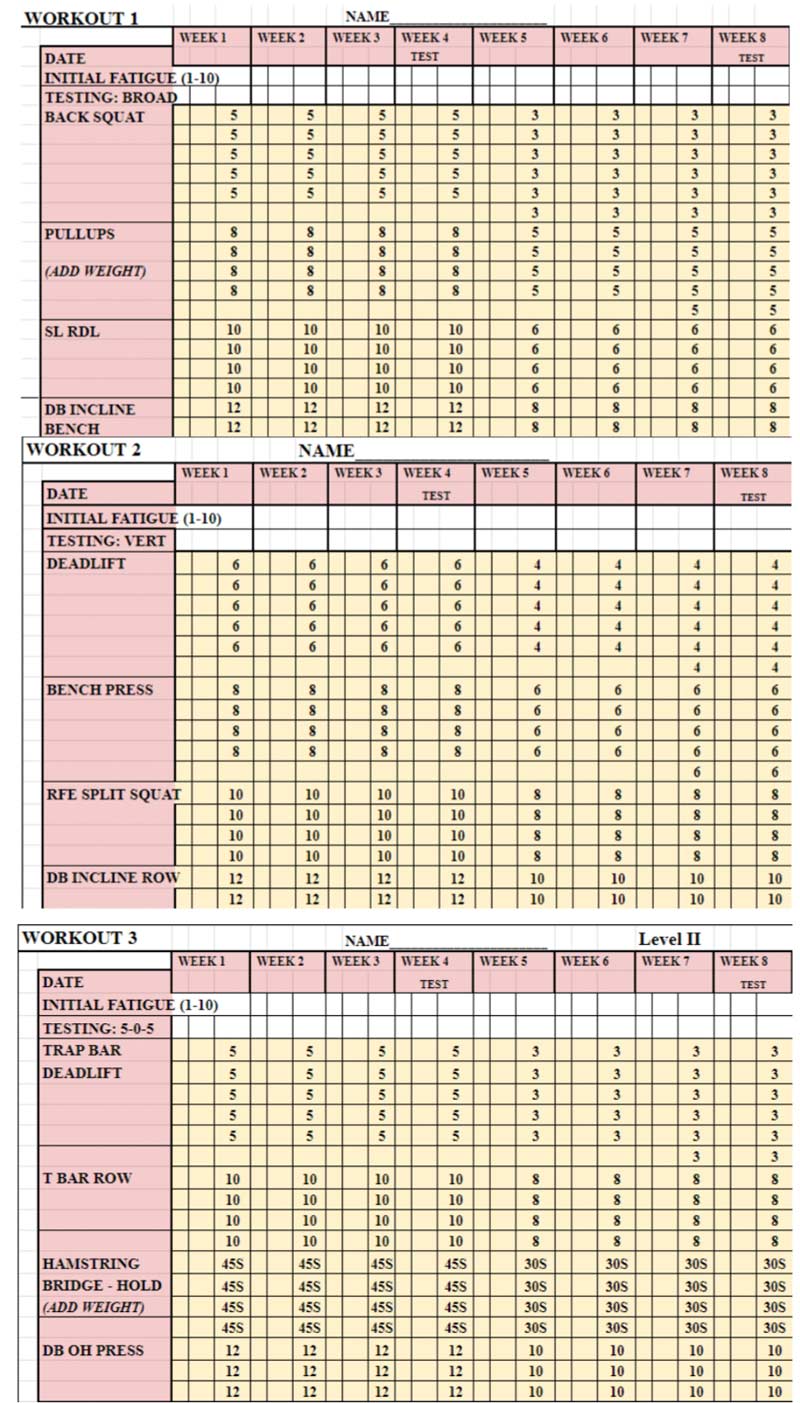
How do I get my athletes stronger? This is one of the main questions we strength and conditioning coaches ask ourselves. Strength lays the foundation for all specialty strengths—explosive strength, speed strength, strength endurance, etc.—and is a quality athletes of all levels need to possess and improve.
As a coach in the private sector working with athletes of all different skill levels and training ages, I had to determine a way to help them all gain strength with methods that were appropriate to them individually. The 14-year-old first-time lifter and the 26-year-old Pro Bowler need different stressors to elicit the adaptation of strength—so I needed to figure out how to get all types of athletes stronger.
Let’s take a deep look at the principles and methods needed to improve strength in all different levels of athletes. Whether you’re a high school, collegiate, professional, or private-sector coach, you likely see athletes of all different training ages and strength levels. This article will cover how to continue to build strength over time and what athletes of varying strength levels should focus on.
What Is Strength?
Strength—specifically absolute or maximal muscular strength—is commonly defined as the measurement of the force that a muscle can produce. This is not to be confused with strength endurance, relative strength, or different types of speed strength. So, strength is how much force a muscle can produce, and force is defined as mass multiplied by acceleration (F=MA). Acceleration is the increase in velocity or speed, and mass is the load. The heavier the load being moved, the more force being exerted.
An isokinetic dynamometer is the gold standard in exercise science research for measuring muscular strength.1 If you are unfamiliar with isokinetic dynamometers, it is because they are not commonly (if at all) found in weight rooms but are instead in scientific laboratories. Force plates are some fancy pieces of training equipment becoming more and more common at the collegiate and professional levels. These high-tech scales can also be useful for strength measurements like the isometric mid-thigh pull.
The most common and most affordable way to measure strength is through 1 repetition max strength testing with specific exercises such as squats, benches, and deadlifts, but you can use any exercise. Test how much an athlete can lift with a bench press, then try again after six weeks of training. If they can lift more, they got stronger.
How Do Athletes Get Stronger?
Two main categories of adaptations lead to getting stronger: neural and muscular. Neural adaptations refer to the changes in how the brain tells the muscle to contract. The brain has to tell the muscles to move the weight.
Two main categories of adaptations lead to getting stronger: neural and muscular. We like to think that a bigger muscle has the potential to be stronger, but neural adaptations are needed as well. Share on XNeural Adaptations
- Motor unit recruitment – activating more muscle fibers. Untrained lifters may only activate 71% of the muscles used to complete a lift.2 Obviously, being able to utilize more muscle fibers would be beneficial, and the body gets better at this with more training.
- Motor unit synchronization – Motor unit recruitment is about the lifter being able to utilize more muscle fibers; synchronization refers to activating them quickly. When it’s time to press the weight, it’s good to have all hands on deck immediately.
- Decreased Golgi tendon organ inhibition – Golgi tendon organs are proprioceptors (sensory receptors that receive information from the body and communicate with the central nervous system) that sense tension, and they’re located in the tendon. The job of Golgi tendon organs is to measure the tension being produced and keep the lifter in a safe range of tension. Too much tension/force/stress can lead to injury, which is precisely what these proprioceptors are trying to avoid. To avoid too much tension, the Golgi tendon organs tell the central nervous system to limit the amount of force being produced. Training with heavier weights inhibits this and allows the muscle to exert more force.
- Intra and intermuscular coordination – Intramuscular coordination refers to how muscle fibers within a muscle work together. Intermuscular coordination is how different muscles work together. Both of these are important to get the muscles and muscle fibers to activate and fire in the proper timing and order.
The muscular changes can be less complicated. Muscle fibers get bigger with strength training. A bigger muscle is typically a stronger muscle. We like to think that a bigger muscle has the potential to be stronger, but neural adaptations are needed as well. Bigger muscles are not always stronger (look at bodybuilders versus powerlifters). The muscle has to literally move the bones; they are the tissue responsible for producing force. Muscle growth gets explained a little more in-depth in our previous article focusing on hypertrophy.
So, to get stronger, an athlete needs a muscle big enough and strong enough to complete the task, along with the central nervous system activating more muscle, activating the muscles quickly and in the proper order so that they work together.
Strength Adaptations for Beginner Athletes
As always, to create a change, there must be a signal or a stressor that forces the body to change. If there is no stress, there is no adaptation. For strength improvements in the beginner athlete, we want to focus on proper form, consistency, and progressive overload—specifically, increasing load over time. These are all the same principles we look for to elicit hypertrophy in beginners.
With younger athletes who cannot build adequate muscle mass, it is important to develop strength appropriately since they can still obtain the neurological benefits of strength training. Share on XStrength and hypertrophy are relatively similar, and there is a lot of carryover between the two. As we coaches know, prepubescent athletes do not have the hormonal profile to develop meaningful hypertrophy. With younger athletes who cannot build adequate muscle mass, it is important to develop strength appropriately since they can still obtain the neurological benefits of strength training. For any fitness adaptation, it is always crucial to perform the movement properly, be consistent, and progress over time.
- Lifting technique. As always, form and technique are important for the safety, health, and longevity of the athlete. Specifically for building strength, you want the athlete to use the best form possible because strength is often movement specific. In the beginner stages, very little hypertrophy takes place, yet athletes get stronger. Most of the strength gains in the beginner stages come from the neural adaptations listed earlier, and part of newbie strength gains come from just getting better at performing the movement.
- Show up. Don’t worry or stress about getting your beginner athletes in the weight room as often as possible. For building strength with a first-time lifter, you can have them do very little and still improve. The most important factor for long-term development is consistency. If they can only commit to one day per week or the sport coach does not want them to get sore during this time of year, it’s fine. One day a week is all that newbies need to gain strength; just get them in consistently over a long period of time.
- Increase load. Almost by definition, the best way to get an athlete stronger is to have them use more weight than they did last time. With a newbie, this is a pretty straightforward process; they can expect to see it happen within a week. There is no need for a special rep scheme with a beginner. Yes, to improve strength, you typically want your athlete to do six or fewer reps per set, but a beginner can do sets of 10 or 12 and still gain strength. The only focus and main principle to gaining strength is to continue to add weight each week, if possible. (With a beginner, this is not only possible but also easy.)

Strength Adaptations for Intermediate Athletes
Your athlete has been training with you for around two years and can lift about 1.5 times their body weight on squats, benches, and deadlifts. There may have even been some strength plateaus recently. We now have an intermediate lifter on our hands who still needs to gain strength. To continue to see strength improvements in my intermediate athletes, I tell them to lift 2–3 days per week with adequate rest between sets and use lower repetitions per set with more working sets. I teach them about the intent of moving the weight as forcefully as possible.
- Days per week and rest intervals. One day a week won’t cut it anymore. If your athlete wants to continue to gain strength, it’s time to put more time in the gym. Two to three days per week seems optimal, though there seems to be controversy over how many days per week is best for strength gains (strength coaches love to find stuff to argue about).
-
Some research has suggested five days a week is best,3 while other research has found even one day a week to be equal.4 Many of these studies are done with the general population, elderly, and untrained individuals—not athletes. There has been some non-clinical and anecdotal evidence of higher frequency training being beneficial for strength improvements: the squat everyday program and the Bulgarian method (I know they were loaded on “supplements” and most people crashed) have been well-known for this. Westside barbell lifters are known to have four main lifts per week, with many smaller workouts throughout the week. Coaches like Cory Schlesinger have established the concept of microdosing strength training with six sessions per week.
-
We have not established an optimal number of days or sets per week, but quality reps, not fatigue, drive strength gains. The trouble with heavy loads is that they can be difficult for the central nervous system to recover from, especially as athletes get stronger and stronger—ask a powerlifter to squat 800 pounds three days per week and see how that goes. Rest intervals are a little more established in the literature. Three to five minutes of rest between sets is optimal for strength training.5 Too short of rest and the ATP-CP energy system does not fully replenish (more on this another day), and too long of rest between sets can cause an athlete to feel “cold” and make the workout last too long.
- Fewer reps, more sets. Again, strength improvements are dictated by quality reps, not a large quantity of reps. As a beginner, the number of reps per set is a little less important—a beginner will get stronger by simply looking at the weights. As athletes get more advanced, they need to get more specific. Absolute strength is a 1RM, so to get more specific, the athlete needs to do sets that have fewer reps. Typically, utilizing sets of six reps or less is specific to training for strength. It is not uncommon to see 5×5, 6×4, 8×3, and even 10×2 in a strength training program. More exposure to heavier weights is the best way to get better at lifting heavier weights.
- Intent of movement. This might be my favorite concept in the intermediate category. Anytime an athlete can focus better on their intent, the growth or adaptation is enhanced. We saw something similar with hypertrophy as well; focus on the muscle being worked, and the muscle grows better. Focus on pushing the weight as forcefully as possible, and the athlete gets stronger than when just going through the motion.6 Who would have thought that if the goal is to get better at producing more force (strength), attempting to produce as much force as possible in each rep is better than not?
-
This goes hand in hand with using fewer reps per set, as the amount of force that can be produced decreases as reps increase. Using fewer reps with longer recovery while pushing (or pulling) the weight as hard as possible is a great formula for improving strength.

Strength Adaptations for Advanced Athletes
The concepts and principles from the earlier stages of athletes looking to improve strength still apply to the advanced lifter. Those are foundational principles that won’t really change. With an advanced athlete who is already very strong relative to their body weight but just needs to add a little more strength for their sport, it’s good to start using some more advanced methods.
NFL linemen love to feel strong at the end of their off-season training. I think it gives them the confidence they need going into training camp. These are some methods we have used with players who love to showcase their strength, like Noah Spence and Jason Poe. These are for advanced athletes: those who are already strong and just need a little more strength for their sport. Most of these methods have been less effective with lower levels of strength. These are very stressful to the neuromuscular system and should only be used at specific times of the year and with low volume.
- Overcoming isometrics. Overcoming isometrics is pushing or pulling a bar into an unmovable object. To maximize motor unit recruitment, the athlete should push or pull as hard as possible for 3–7 seconds. Durations shorter than three seconds don’t allow enough time to fully contract as hard as possible (but can be used to improve power development—this will be discussed in the future), and durations longer than seven seconds can lead to fatigue and a drop-off in motor unit recruitment.
-
Isometrics are incredible for improving strength in specific ranges of motion. As a coach, you can have the athlete perform ISOs in their sticking point or weak position to strengthen it or in a very strong position to recruit as many motor units as possible. Overcoming isometrics allow the athlete to exert over 20% more force than they can with traditional concentric movements.
- Supramaximal eccentrics. Similar to isometric contractions, eccentric muscle contractions allow the muscle to produce more force than concentric movements. Utilizing eccentrics can enable the body to recruit more muscle fibers and exert more force than usual. Supramaximal eccentrics are an advanced method to improve strength by using a load heavier than the athlete can lift concentrically.
-
As with all of these advanced methods, for safety and to maximize benefits, this should be reserved for the advanced lifter. Supramaximal eccentrics can be used on compound movements with spotters available to assist on the concentric portion of the lift. The athlete should control the eccentric portion of the lift for 5–8 seconds. There are also some safe ways to do this without two spotters to help (listed below).
-
Warning: Your athletes will be sore when utilizing any of these methods for supramaximal eccentrics. We suggest not doing these in high volumes and potentially not in season. For the methods below, single-joint exercises are typically easier to perform.
- Two up, one down method. This is a way to do supramaximal eccentrics for unilateral exercises. Two limbs work on the concentric, and one limb controls the eccentric. We have had success using these for leg extension and leg curl machines, single-leg RDLs, single-leg squat to benches, single-arm DB bench presses and shoulder presses, single-arm lat pulldowns, single-arm TRX rows, and chin-ups—although this is not a true single-arm eccentric. Possibilities for this method are endless, honestly, but as a coach, you should pick and choose when to use it. Biceps curls are another easy example, but unless your athlete is coming back from a wrist/elbow injury, I’m not sure how useful this is.
Video 1. Two-up, one-down pull-up. Do a regular pull-up on the way up and emphasize one arm on the way down.
- Cheat up, control down method. This is similar to using a spotter to assist during the concentric portion but uses movements that don’t require spotters. Pull-ups, push-ups, and Nordic hamstring curls are our favorites for this method. Again, biceps curls are another example of this technique, but it all depends on whether they are needed. A bonus idea for this method is doing one type of exercise on the concentric and another on the eccentric—deadlift up, RDL down, push press up and control down, etc.
- Partner-resisted method. This method is typically easiest to use with machines. Have the athlete use a weight they can manage concentrically and a partner who manually adds resistance on the eccentric portion. Leg extensions, leg curls, and lat pull-downs are some favorite exercises with this method, but most machines can be used for this method.
- Accommodating resistance. News flash: Louie Simmons knew what he was talking about. Accommodating resistance—chains and bands—is great for strength improvements. Chains and bands work by increasing load throughout the concentric phase of the movement. Think of the bench press, for example: As the bar is lowered to the chest, the band is shortening and therefore providing less resistance. As the concentric phase begins and the bar rises, the band gets stretched more, providing more resistance to the movement. This is important because the bottom portion of the movement (when muscles are stretched the most) is typically when a lifter is weakest.
-
I cannot remember the last time I saw someone fail a squat rep when they were 2 inches away from standing straight up; they typically fail toward the bottom of the lift. So, the top portion of the lift never gets stressed maximally. Chains and bands allow the movement to remain equally difficult throughout—providing the lifter with the experience of a heavier load at the top of the movement when they are strongest and a lighter load at the bottom when they are weakest.8
Video 2. Accommodating resistance deadlift. During the concentric portion of the movement, the band stretches, adding more resistance throughout the range of motion.
- Partials. Similar to the idea of accommodating resistance and the strength curve throughout a range of motion, partial ranges of motion can be beneficial to stress the top portion of a given exercise. Examples include floor press, board press, pin press, and rack pulls. If we take a look at what the strongest people in the world do (powerlifters), partials have proved to be beneficial. Again, these are typically used at the top of the range of motion where the lifter can use more weight than they would throughout the full range, but they also can be used in a specific range of motion that may be very specific to the sport.
- Clusters. This training method was made popular by Jake Tuura… or was it Charles Poliquin… or Carl Miller? It depends on which era you heard it in, but this is a method that has been proven to be effective. For whatever reason, it seems to gain popularity every 10 years or so. It goes like this: instead of doing five sets of four reps with a four-minute rest between sets, the athlete rests 10–20 seconds between each rep within a set, then rests two minutes between sets. This has been shown to allow athletes to maintain bar velocity throughout a set and use a heavier load for the same amount of total reps. There is evidence that this leads to better neural adaptations.7
- Walkouts and carries. I learned about both these ideas during my internship at Arizona State University under Joe Connolly. At the time, I could barely trap bar deadlift 365 pounds. At the end of one of our workouts, we carried a trap bar (365 pounds) across the width of the football field and back. As much of a struggle as it was to stand up with that much weight, I found a way to carry it 53 and 1/3 yards. This gave my body time to feel that amount of weight and the stress of holding that amount of load. When just doing a trap bar deadlift for a 1RM, your body may have to feel that load for five seconds. Carrying it for a distance with the same weight is an opportunity for the nervous system to get acclimated to that load. This can also be done with yoke carries.
- Walkouts, which I also learned about for the first time at ASU, are a very similar concept. The athlete doesn’t actually complete a movement, not even a partial range of motion, but instead just unracks the weight and holds it for some time—generally around 10 seconds. For this concept, an athlete should use a weight about 10%–20% heavier than their 1 rep max (this is best on squat or bench press). They simply need to unrack the weight and hold it. This supramaximal load allows the body to activate high-level motor units without the stress of completing the movement. This is a great concept for in-season training to maintain strength while sore and fatigued from sport or during a peak phase.
Video 3. Squat walkout. Simply unrack the weight and brace during the duration of the hold.
All of these advanced strength training methods have been utilized for football players preparing for the NFL Combine. These methods are not only found to be effective in practical settings but in research labs as well.
A Career-Long Lifting Program
Athletes should utilize all of these methods to gain strength throughout their athletic careers. These are the tools we coaches need to know to continue to help our athletes grow and adapt over a long period.
Since you’re here…
…we have a small favor to ask. More people are reading SimpliFaster than ever, and each week we bring you compelling content from coaches, sport scientists, and physiotherapists who are devoted to building better athletes. Please take a moment to share the articles on social media, engage the authors with questions and comments below, and link to articles when appropriate if you have a blog or participate on forums of related topics. — SF
 Alex Roberts is the Strength and Conditioning Coach at R. Nelson Snider High School in Fort Wayne, Indiana. In this role, he’s responsible for the year-round athletic development of all student-athletes. Coach Roberts’ main responsibilities are teaching strength training classes during the school day, leading after-school training sessions, and running the summer strength and conditioning program. He holds a Master of Science in Kinesiology and is CSCS certified through the NSCA.
Alex Roberts is the Strength and Conditioning Coach at R. Nelson Snider High School in Fort Wayne, Indiana. In this role, he’s responsible for the year-round athletic development of all student-athletes. Coach Roberts’ main responsibilities are teaching strength training classes during the school day, leading after-school training sessions, and running the summer strength and conditioning program. He holds a Master of Science in Kinesiology and is CSCS certified through the NSCA.
References
1. Parraca JA, Adsuar JC, Domínguez-Muñoz FJ, Barrios-Fernandez S, and Tomas-Carus P. “Test-Retest Reliability of Isokinetic Strength Measurements in Lower Limbs in Elderly.” Biology (Basel). 2022 May 24;11(6):802. doi: 10.3390/biology11060802. PMID: 35741323; PMCID: PMC9219978.
2. Adams GR, Harris RT, Woodard D, and Dudley GA. “Mapping of electrical muscle stimulation using MRI.” Journal of Applied Physiology. (1985). 1993 Feb;74(2):532–537. doi: 10.1152/jappl.1993.74.2.532. PMID: 8458767.
3. McKenzie Gillam G. “Effects of frequency of weight training on muscle strength enhancement.” The Journal of Sports Medicine and Physical Fitness. 1981 Dec;21(4):432–436. PMID: 7339229.
4. McLester JR, Bishop E, and Guilliams ME. “Comparison of 1 Day and 3 Days Per Week of Equal-Volume Resistance Training in Experienced Subjects.” Journal of Strength and Conditioning Research. 2000 Aug;14(3):273–281.
5. de Salles BF, Simão R, Miranda F, da Silva Novaes J, Lemos A, and Willardson JM. “Rest interval between sets in strength training.” Sports Medicine. 2009;39(9):765–777. doi: 10.2165/11315230-000000000-00000. PMID: 19691365.
6. González-Badillo JJ, Rodríguez-Rosell D, Sánchez-Medina L, Gorostiaga EM, and Pareja-Blanco F. “Maximal intended velocity training induces greater gains in bench press performance than deliberately slower half-velocity training.” European Journal of Sport Science. 2014;14(8):772–781. doi: 10.1080/17461391.2014.905987. Epub 2014 Apr 15. PMID: 24734902.
7. Haff G, Burgess SJ, and Stone M. “Cluster training: theoretical and practical applications for the strength and conditioning professional.” UKSCA Journal. 2008;12:12–16.
8. Berning JM, Coker CA, and Adams KJ. “Using Chains for Strength and Conditioning.” Strength and Conditioning Journal. 2004 Oct;26(5):80–84.

